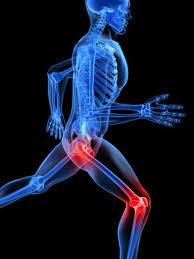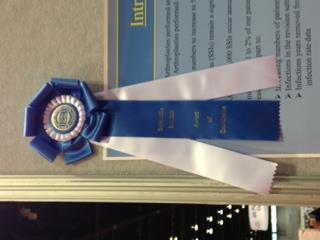November node call agenda
Joining Organizations
In Tackling SSIs
SCPSF Collaborative Meeting "Learning from Each Other"
Kathy Duncan, RN
Faculty, Institute for Healthcare Improvement
November 5, 2013

The Case for Improvement
• 327,000 total hip (THA) and
676,000 total knee (TKA)
arthroplasties are performed
annually in the US
• Projected increase of 572,000
THA ( 174%) and 3.48 million
TKA ( 673%) through 2030
• Infection rates currently at
1.5% for THA and 1.2% for TKA
Kurtz S, Ong K, Lau E, Mowat F, Halper M. Projections of primary and revision hip and knee arthroplasty in the Unites States from 2005 to 2030. J Bone Joint Surg Am, 2007 Apr;89(4):780-785



What is Project JOINTS?
An initiative funded by the federal government to give
participants support from IHI in the form of in-person and
virtual coaching on how to test, implement and spread
the enhanced SSI prevention Bundle comprised of three
new Evidence-based Practices as well as the two
applicable Surgical Care Improvement Project (SCIP)
practices.
Two cohorts of 5 states with a 6 month intervention period. (May 2011-October 2012)
Support & Contributions
American Academy of Orthopaedic Surgeons (AAOS/Academy)
– "The JOINTS project is a remarkable endeavor and the
Academy looks forward to working with you to accomplish the goal of eliminating preventable SSIs."
AORN Hospitals already engaged in the "new" interventions.
Offer implementation support to participants on the recommended interventions to reduce prevent hip and knee SSIs
Build a network of facilities that are working together
toward the same aim – literally Joining Organizations IN
Tackling SSIs
Test IHI's ability to spread evidence-based practice


AAOS Annual Meeting 2013
Award of Excellence at the March American Academy of Orthopaedic Surgeons 2013 Meeting: "Reducing Surgical Site Infections in Total Joint Arthroplasty: It's a War and not Just One Battle". Drs Brian Hamlin and Tony DiGioia III.
SSI Prevention For Hip and Knee Arthroplasty
New Practices:
– Use of an alcohol-containing antiseptic agent for pre-op
– Pre-op bathing or showering with chlorhexidine gluconate
(CHG) soap for at least 3 days prior to surgery
– Staph aureus screening and use of intranasal mupirocin
and CHG bathing or showering to decolonize staph aureus carriers
Applicable SCIP practices:
– Appropriate use of prophylactic antibiotics – Appropriate hair removal
#1: Use an alcohol-containing antiseptic agent for preoperative skin preparation
Use an alcohol-containing antiseptic
agent for preoperative skin preparation
Adequate preoperative skin preparation to prevent entry of skin flora into the surgical incision is an important basic infection prevention practice. Preoperative skin preparation of the operative site involves use of an antiseptic agent with long-acting antimicrobial activity, such as chlorhexidine and iodophors. Two types of preoperative skin preparations that combine alcohol (which has an immediate and dramatic killing effect on skin bacteria) with long-acting antimicrobial agents appear to be more effective at preventing SSI than povidone-iodine (an iodophor) alone:
–CHG plus alcohol – Iodophor plus alcohol
Cochrane Systematic Review 2009: Does Pre-Operative Skin Antisepsis Prevent SSI?
CHG vs. PI (Berry 1982): Higher SSI rate with PI PI vs. iodophor-alcohol (2 studies): No significant difference Single vs. multiple-step application (4 studies): No significant difference Iodophor-impregnated drapes vs. regular drapes (4 studies): No significant difference Conclusion: Insufficient evidence to support recommending the use of one antiseptic agent over another
Use an alcohol-containing antiseptic agent
for preoperative skin preparation
Behavioral Objective: Change the operating room skin prep for hip and
knee arthroplasty to a long-acting antiseptic agent in combination with alcohol.
Assess your current process and potential barriers:
Identify surgeons currently using an alcohol-based skin prep to champion the change in practice with their peers.
Determine the high-volume surgeons and focus your efforts on working with them.
Conduct brief interviews with representative surgeons to identify any misconceptions or key barriers to using an alcohol-based skin prep.
Provide a brief summary of the scientific evidence supporting change to an alcohol-containing skin prep to influence change of habit/tradition.
#2 Pre-op bathing or showering with
chlorhexidine gluconate (CHG) soap
for at least 3 days prior to surgery
Why consider preoperative CHG bathing or showering to prevent SSIs?
Topical chlorhexidine significantly reduces bacterial counts on skin and has a residual antimicrobial effect
– Impacts a broad range of potential pathogens – Low risk of skin reactions
There is progressive reduction in counts when used serially up to 3 times preoperatively
– Hayek J Hosp Infect 1987 – Kaiser Ann Thor Surg 1988 – Garibaldi J Hosp Infect 1988, – Paulson AJIC 1993
•Effectiveness of CHG washes depends mainly on the residual antimicrobial effect, which is increasingly effective the more consecutive days it is used
•At least 3 consecutive washes are needed to keep skin flora lower than baseline through a 24-hour period
Paulson DS. Efficacy evaluation of a 4% chlorhexidine gluconate as a full-body wash. Am J Infect Control
1993;21:205-209.
Why is this recommendation controversial?
Cochrane Systematic Review 2011: no clear evidence based on RCTs that preop bathing with CHG reduces the incidence of SSI
Studies had many limitations:
– Variable SSI definitions and follow-up – No monitoring of compliance with CHG use – Most used only 1 or 2 applications of CHG soap
May need repeated applications (i.e., showering
with CHG at least 3 times prior to surgery)
Ask patients to bathe or shower with chlorehexidine
gluconate (CHG) for at least 3 days prior to surgery
Behavioral Objective: Provide patients with chlorhexidine soap, and
have them use the soap in bathing or showering for at least three days before surgery.
Assess your current process and potential barriers:
Assess where most preoperative assessments take place
Assess current preoperative communication between the hospital OR department and the offices of orthropaedic surgeons inside and outside the hospital.
Tailor the implementation process to your setting
Develop a process flow diagram to define all components of the process
#3:Screen patients for Staphylococcus aureus (SA) carriage and decolonize SA carriers with 5 days of intranasal mupirocin and at least 3 days of CHG soap prior to surgery
Why Worry About Staph Aureus Nasal Carriage?
Staphylococcus aureus nasal colonization predisposes patients to invasive S. aureus infections
– Nasal carriage of S. aureus is associated with a
relative risk of 7.1 for developing SSI (Kluytmans J Infect Dis 1995)
– Most cases of invasive S. aureus infection are
due to endogenous strains (Von Eiff NEJM 2001, Huang CID 2008)
Does Using Mupirocin Eradicate S. Aureus Nasal Carriage?
Systematic review (Ammerlaan HS, et al. CID 2009): 8 studies comparing mupirocin to placebo
– Short-term nasal mupirocin (4-7 days) was an
effective method for S. aureus eradication
– 90% success at one week, 60% at longer (14-365
– 1% develop mupirocin resistance
Does Using Mupirocin Prevent SSIs?
Meta-analysis (Kallen ICHE 2005):
– 3 randomized and 4 before-after trials – Conclusion: Mupirocin use was associated with a
small reduction in SSI rates for non-general surgery (cardiothoracic, orthopedic, neurosurgery: 6.0% vs. 7.6%) but not for general surgery
Does Using Mupirocin Prevent SSIs?
Systematic review (van Rijen JAC 2008): Included 4 randomized controlled studies
– Conclusion: Mupirocin use was associated with a
significant reduction in S. aureus postoperative infection rates among S. aureus carriers (RR 0.55, 95% CI 0.34-0.89)
Randomized, double-blinded, placebo-controlled multicenter study of 6,771 patients in the Netherlands (Bode NEJM 2010) Rapid screening for MSSA/MRSA on admission Carriers randomized to mupirocin/CHG soap vs. placebo/bland soap x 5 days
(Continued) Bode NEJM 2010
Results: CHG bathing + mupirocin group had significantly lower SSI rates than the placebo group
Conclusion: Preoperative identification of S. aureus carriers followed by 5 days of intranasal mupirocin plus CHG bathing reduced S. aureus SSIs by 60%
Decolonization for Orthopedic Surgery
Decolonized
Population
Only S. aureus
Only S. aureus
Only S. aureus
Kalmeijer,
This and next slide provided by Schweizer M, Perencevich E, Herwaldt L, Carson J, Kroeger J, Ward M
Screen patients and Decolonize SA carriers w/5
days intranasal mupirocin & 3 days CHG
Behavioral Objective: Screen all patients for Staphylococcus aureus
prior to surgery, allowing enough time for those who screen positive to be decolonized with five days of intranasal mupirocin.
Assess your current process and potential barriers:
Assess where most preoperative assessments take place
Tailor the intervention to the setting in which preoperative assessment is done
Work with Lab to assure screening includes both MRSA and MSSA
Develop a process to assure info on screening and decolonization is available at the time of surgery
Develop a process flow diagram to define components of the process
IHI JOINTS SSI Reduction Project
2012 - 2013
SSI Bundle Elements
IHI data submitted;
appropriate prep
performed as part
for TJ since 2009
developing testing
process to perform
decolonization of +
process for MRSA/
culture for MRSA
Independent Ortho
Independent Ortho
Practice provided
implementation of
began participation
for Element II &

Screening results- Canton Potsdam
2011 Volume = 110
Known MRSA: 2= 2%
Total MRSA & MSSA : 21= 14.4%
Captured with nasal screen = 14.4%
Total MRSA & MSSA: 21= 21 %
Captured with nasal screen = 19%
2013 Volume = 22
Total MSSA & MRSA: 6= 28%
Captured with nasal screen= 18%
2012 Volume = 146
Known MRSA: 0= 0%
Mercy St Joseph's -JOINT PROGRAM
UT Medical Center
recommendations of
Project JOINTS in
Spring/Summer 2011.
Holy Family Memorial-Manitowoc, WI 32
Total Joint Patient August 2012 – March 2013
8/156 – 5.1% - Positive for MRSA
34/156 – 21.7% - Positive for SA
ZERO Hip Infections!
0.46 Knee Infection Rate!
Ministry Saint Michael's
Consistently lower infection rate than national average No infections since March 2012. Integration of independent practice group Recognized as IHI exemplar hospital for all 3 elements

Impact to patients
Patients going
Length of Stay
directly home
FY 2012 FY2013 (to
FY 2012 FY2013 (to
FY 2012 FY2013 (to
• Improved patient experience • Reduced patient recovery time • Reduced patient charges
Patient Affordability
Resources – www.ihi.org/projectjoints
Exemplar Hospitals
Surgery Data Tracker
Resources for you
Patient instruction sheets and checklists
Protocols for staff
Evidence 1-pager
Over 30 exemplars
Safer Surgery from Start to Finish – Dr Anthony DiGioia
Strong for Surgery – Dr Thomas Varghese
Innovative Strategies for SSI Prevention- Dr Debbie Yokoe
Pre-Operative Processes Post-Admission – Dr Gerry Healy
Peri Operative Processes – Dr Bill Berry
Post Operative Processes- Dr Bill Berry
Pre-conference sessions on December 8-9:
• 30 Learning Labs • 30 Minicourses
General Conference on December 10-11
• 4 keynote presentations • 75 unique workshops • 130 Exhibitors • 400 storyboards • Over 5,000 attendees from over 47 countries
Scholarships and discounts available for individuals
and groups
Questions? [email protected]
Source: http://www.nhfca.org/psf/materials3/KEYNOTE%20II_PROJECT%20JOINTS-Joining%20Orgs%20In%20Tracking%20SSIs_UPDATED_Kathy%20Duncan.pdf
MEDICINA - Volumen 75 - Nº ISSN 2, 2015 MEDICINA (Buenos Aires) 2015; 75: 124-129 NEUMONÍA GRAVE DE LA COMUNIDAD Y NEUMONÍA ASOCIADA AL RESPIRADOR EN UN ENFERMO CON DESINHIBICIÓN DE LA CONDUCTA EDITORES: PABLO J. LANDI, GISELL A. TORREJÓN FERNÁNDEZ, CARLA GAZZI Hombre, 73 años. HC 117963. Fecha de ingreso: 29/06/2012. cardíaco sistólico intensidad 3/6 en foco aórtico y mitral,
Inorg. Chem. 2004, 43, 2114−2124 Coordination Complexes of Molybdenum with 3,6-Di-tert-butylcatechol.Addition Products of DMSO, Pyridine N-oxide, and TriphenylarsineOxide to the Putative [MoVIO(3,6-DBCat)2] Monomer and Self-Assemblyof the Chiral [{MoVIO(3,6-DBCat)2}4] Square








